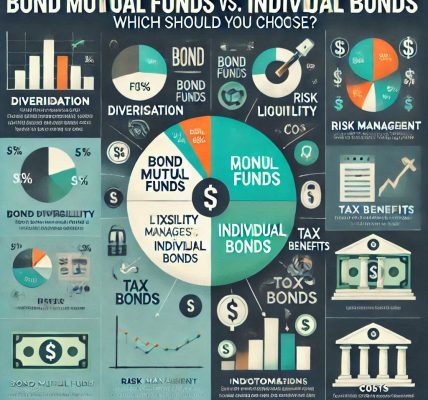Investing in bonds is an excellent way to generate stable income while diversifying your investment portfolio. However, with so many options available, one key decision you’ll face as an investor is whether to choose short-term or long-term bonds. Each type has its unique benefits and risks, and understanding the differences can help you make the right decision based on your financial goals, risk tolerance, and investment horizon.
In this blog, we will explore the differences between short-term and long-term bonds, their advantages and disadvantages, and how to choose the right bond for your investment strategy.
What Are Short-Term and Long-Term Bonds?
Before diving into the differences, it’s important to understand what short-term and long-term bonds are.
- Short-Term Bonds: These bonds have a maturity period of one to three years. They are typically issued by governments, municipalities, or corporations and provide regular interest payments over the bond’s term. Short-term bonds are generally considered low-risk investments due to their shorter duration and lower sensitivity to interest rate changes.
- Long-Term Bonds: These bonds have a maturity period of more than ten years, with some bonds maturing in 20 or even 30 years. Long-term bonds tend to offer higher interest rates (yields) in exchange for the increased risk associated with longer holding periods. Their value is more sensitive to changes in interest rates, which can lead to greater volatility.
Key Differences Between Short-Term and Long-Term Bonds
To help you decide between short-term and long-term bonds, it’s important to understand how each type works in different market conditions. Here are the key differences:
- Interest Rate Sensitivity:
- Short-Term Bonds: Short-term bonds are less sensitive to interest rate changes because their maturity period is relatively brief. If interest rates rise, the price of short-term bonds will typically not decrease as significantly as long-term bonds. This makes them a safer choice for conservative investors who want to minimize price fluctuations.
- Long-Term Bonds: Long-term bonds are more sensitive to interest rate changes. When interest rates rise, the price of long-term bonds can drop significantly, making them more volatile than short-term bonds. However, they usually offer higher yields to compensate for this risk.
- Yield (Return on Investment):
- Short-Term Bonds: Short-term bonds typically offer lower yields compared to long-term bonds. This is because investors are willing to accept lower returns for the safety and stability that comes with a shorter investment horizon.
- Long-Term Bonds: Long-term bonds often offer higher yields to attract investors who are willing to lock in their money for a longer period. These bonds may be more appealing to investors seeking higher returns and willing to tolerate greater risk.
- Risk:
- Short-Term Bonds: Since short-term bonds have shorter durations, they generally carry less risk than long-term bonds. Their prices are less affected by market volatility and interest rate changes, making them a safer option for risk-averse investors.
- Long-Term Bonds: Long-term bonds carry more risk due to their extended maturity periods. Changes in interest rates, inflation, or economic conditions can significantly impact their prices. However, they may be a good option for investors with a higher risk tolerance who are looking for higher yields.
- Liquidity:
- Short-Term Bonds: Short-term bonds are generally more liquid than long-term bonds, meaning they can be sold or traded more easily. This makes them a good option for investors who may need quick access to their funds.
- Long-Term Bonds: Long-term bonds are less liquid due to their longer holding periods. It may be harder to sell them quickly, and investors could face a greater risk of price fluctuations if they need to sell before maturity.
- Tax Considerations:
- Short-Term Bonds: Interest earned on short-term bonds is generally subject to federal and state income taxes. However, some types of short-term bonds, such as municipal bonds, may offer tax advantages.
- Long-Term Bonds: The interest on long-term bonds is also subject to taxes, but certain bonds, like municipal bonds, may offer tax-free income. Additionally, long-term bonds might be more suitable for tax-deferred retirement accounts.
Advantages of Short-Term Bonds
- Less Price Volatility: Short-term bonds are less affected by interest rate changes and inflation, making them more stable.
- Quicker Access to Funds: With a shorter maturity period, you’ll be able to access your money sooner and reinvest it if needed.
- Lower Risk: They are considered safer investments compared to long-term bonds, making them ideal for conservative investors or those near retirement.
Advantages of Long-Term Bonds
- Higher Yields: Long-term bonds typically offer higher interest rates, making them attractive to income-seeking investors.
- Long-Term Stability: For investors who can afford to lock in their money for an extended period, long-term bonds provide a consistent stream of income over many years.
- Potential for Capital Gains: If interest rates fall, long-term bond prices tend to rise, potentially providing investors with capital gains in addition to the interest income.
How to Choose Between Short-Term and Long-Term Bonds
Your decision between short-term and long-term bonds should be based on your financial goals, risk tolerance, and time horizon. Here are some factors to consider when making your choice:
- Investment Horizon: If you need access to your funds in the near future, short-term bonds may be a better choice. On the other hand, if you don’t need immediate access to your capital and are comfortable holding investments for a longer period, long-term bonds may offer greater returns.
- Risk Tolerance: If you prefer low-risk, stable investments, short-term bonds are likely the better choice. For investors with a higher risk tolerance seeking higher yields, long-term bonds can be an attractive option.
- Interest Rate Outlook: If you anticipate that interest rates will rise, short-term bonds may be more favorable because they are less sensitive to interest rate changes. Conversely, if you expect rates to fall, long-term bonds may benefit from price appreciation.
- Diversification: Many investors choose to diversify their portfolios by including both short-term and long-term bonds. This strategy can provide a balance of safety and yield, allowing you to manage risk while still earning a competitive return.
- Tax Considerations: If you’re in a higher tax bracket, long-term municipal bonds may offer tax advantages that short-term bonds cannot. Consider your tax situation before deciding which bond type to invest in.
Conclusion
Both short-term and long-term bonds offer unique benefits and risks, and the best choice for you depends on your specific financial goals, risk tolerance, and investment horizon. Short-term bonds are ideal for those seeking stability and liquidity, while long-term bonds offer higher yields and potential for capital gains.
By understanding the differences between these two types of bonds and aligning them with your financial situation, you can make an informed decision that enhances your overall investment strategy. Whether you choose short-term or long-term bonds, incorporating them into your portfolio can help you achieve financial security and a steady income stream in the long run.




